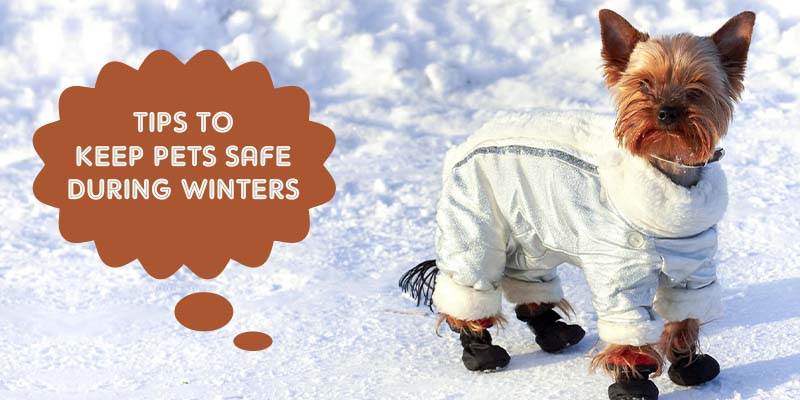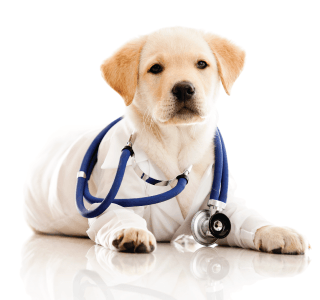11 Tips to Keep Pets Safe During Winters

Winter can be tough on all of us and our furry friends are no exception. Be it our pets or livestock, the bitter season poses a serious threat to animals’ health. Therefore, it is important to offer extra protection to keep them safe and secure during the cold weather. Pet care in winter includes making adjustments to the animal’s routines to keep up with the weather.
To help you out, we have come up with the most effective tips to help you keep your furry babies warm and safe during the chilly months.
1. Brace up for the season
Besides the cold weather, winter also comes with blizzards and power outrages. To combat emergencies, we advise that you prepare a disaster/emergency kit, keeping your pet in mind. Store a sufficient amount of food, medicines and water to sustain at least for 5 days.
2. Keep an eye on your pet’s food intake
Similar to humans, animals need calories for energy, which they get from their food. The number of calories that an animal needs depends on their weight and coat type. Dogs and cats with thin or hairless coats and low body fat require more calories to maintain their body heat. Whereas, pets that have a thick coat and higher body density may need less energy as they are already protected from the cold weather and don’t need to exercise to remain warm.
[Also Read] Obesity in Dogs and Cats and How to Handle It
3. Protect your pet’s paws
Irrespective of the weather, dogs always need to spend time outdoors to have their daily exercise and routines. Stepping out in cold weather exposes them to rough and icy sidewalks. You can buy a pet paw protector that acts as a barrier between your pet’s paws and cold surfaces.
4. Moisturize your pet’s skin
Similar to humans, even cat’s and dog’s skin can get dry in the winter. Whenever you bathe them, use a good quality calming shampoo that will subside their itching. You can also apply coconut oil to your pet’s coat to keep it moisturized.
5. Be careful of frostbite and hypothermia
Frostbite and hypothermia are rare conditions but can be fatal to pets that are exposed to extreme cold weather. The best way to keep your pet protected is by limiting the time it spends outdoors and remaining vigilant of signs and symptoms.
Frostbite:
Wet pets are most prone to getting frostbite. It happens when extreme cold weather damages the skin of the animals. Symptoms include grey or blue discoloration of the affected skin, dead skin patches, swelling, coldness of the skin and blisters.
Hypothermia:
Hypothermia occurs when a pet’s body temperature gets much lower than normal. Symptoms of hypothermia include muscle stiffness, weakness, difficulty in breathing and coldness of the skin.
If you feel your pet has frostbite or hypothermia, shift them to a dry and warm area and get them checked by your vet immediately.
6. Dress them up
If your pooch or kitty is suffering from the cold weather, consider making them wear a sweater or a coat. You can dress your pet each time it is stepping out of home. You can also make it wear booties but make sure they fit them properly.
7. Offer shelter
If you are unable to accommodate your pet inside your home, during the winter, make sure to offer it a worm and durable shelter. Ensure that the floor of the shelter is off the ground and the bedding is thick and dry.
8. Keeping livestock safe during the winters
Besides companion animals, even livestock need to be protected when the weather gets harsh. Let’s have a look at the unique requirements that such animals need when the weather gets colder.
9. Keep them covered
Extreme temperatures can have severe effects on your livestock. It can lead to hoof damage and frostbite. Keeping the animals indoors is the best way to secure them from freezing temperatures and harsh weather. You can also use windbreaks if an indoor shelter is not available. A row of trees, a hedge, a fence or a screen can protect your livestock from the strong winter wind.
10. Keep extra feed ready
Your livestock will need to eat more to regulate their body temperature in winter. Cattle, hogs and horses generally eat twice their normal feed during the chilly weather. To cater to their requirement, we advise you to offer them nutritional supplements to make sure they are getting the correct amount of nutrition.
11. Take care of the young ones
Young animals like lambs, foals and calves are vulnerable to cold temperatures. If you have limited shelter, make sure to accommodate the young ones first. If you have no shelter, make sure to at least provide simple windbreaks to protect the babies from biting cold winds.
Wrapping Up
As a pet lover, if you come across a pet suffering from cold, gently let their parents know about it as not all pet parents are aware of the risk that winter poses to their pets and livestock. If you still somehow find the concerned pet parent not responding to your concern, don’t hesitate to reach out to the relevant authorities, but first, ensure the animals’ safety.

David joined CanadaVetCare in 2013 as a product analyst and veterinary assistant. Being a passionate pet lover and keen animal health researcher, David had always found ways and solutions to help pet parents to improve their pets’ health. He is always happy to answer pet health-related queries and recommending pet parents for the right pet product for their furry companions.

